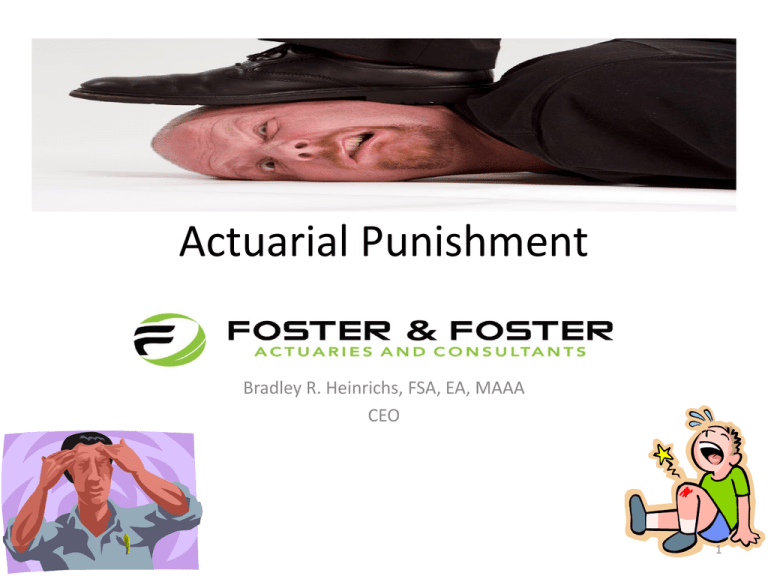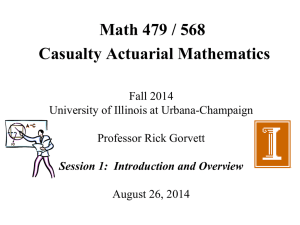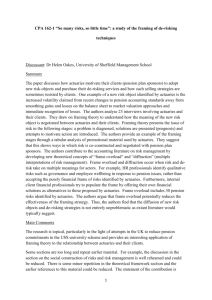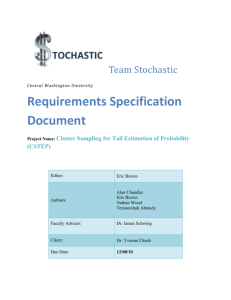Actuarial Punishment - LAPERS Louisiana Association of Public
advertisement

Actuarial Punishment Bradley R. Heinrichs, FSA, EA, MAAA CEO 1 Actuarial House of Pain Agenda • “I hear voices!!” • “The painful, not-so-great GASB” • “I see dead people!! But maybe not as many as before!!” 2 “I hear voices!! Where are they coming from?” The Alphabet Soup of Actuarial Organizations • SOA – Society of Actuaries – Pension Section but no public pension specific section – www.soa.org • AAA – American Academy of Actuaries – Public Plan Interest Group – www.actuary.org • CCA – Conference of Consulting Actuaries – Public Plans Community – www.ccactuaries.org • ASB – Actuarial Standards Board – 9 members appointed by leadership of other organizations – Establishes and maintains actuarial standards of practice (ASOPs) – www.actuarialstandardsboard.org 3 “I hear voices!! Where are they coming from?” Recent Publications The American Academy of Actuaries (AAA) - Feb 2014 Issue Brief on Public Plan Funding Society of Actuaries (SOA) - Feb 2014: Report of the Blue Ribbon Panel on Public Pension Plan Funding The Government Finance Officers Association (GFOA) - Mar 2013 Core Elements of a Funding Policy The Conference of Consulting Actuaries (CCA) - Feb 2014 Actuarial Funding Policies and Practices for Public Pension and OPEB Plans (Discussion Draft) 4 American Academy of Actuaries Issue Brief: Objectives and Principles for Funding Public Sector Pension Plans Key Points: Funding policies should be developed to maintain an appropriate balance among competing objectives: 1. benefit security 2. generational equity 3. contribution stability Policymakers should communicate how these objectives have been balanced, and how, when and whether or not all of the identified costs are expected to be met via the contribution allocation procedure 5 Society of Actuaries Report of the Blue Ribbon Panel on Public Pension Plan Funding • Commissioned by the SOA to develop recommendations for strengthening public plan funding • Composed of mostly non-actuaries, and included only one actuary currently practicing in the public sector Final recommendations were supposedly based on survey responses from public plan actuaries and organizations representing public plans, personal meetings with actuaries, members of the Actuarial Standards Board, economists, an investment advisor, plan administrators, public sector pension plan organizations, a rating agency, trustees, and unions. 6 Society of Actuaries Report of the Blue Ribbon Panel on Public Pension Plan Funding • Report identifies same three (3) principles that the American Academy of Actuaries did in their “brief”: Adequacy – – Strive to fund 100% of the obligation for benefits – Assumptions should be consistent with median expectations about future economic conditions – Assets should be adequate to fund benefits over a broad range of expected future economic outcomes Intergenerational Equity – – Align the cost of services with the taxpayers who benefit from those services Cost Stability and Predictability – – Important for funding and budgeting • Difference is that Blue Ribbon Panel opined that benefit security and intergenerational equity is more important and takes precedence over contribution stability!!! 7 Society of Actuaries Report of the Blue Ribbon Panel on Public Pension Plan Funding Risk Measures Analysis and Disclosures Recommend increased disclosures regarding the expected future position of the trust and of the nature and extent of risks facing public plans. The Panel urges the Actuarial Standards Board to require the following disclosures: – Trends in financial and demographic measures – Measures of risk to the plan’s financial position – Stress testing – Undiscounted cash flows 8 Society of Actuaries Report of the Blue Ribbon Panel on Public Pension Plan Funding Risk Measures Analysis and Disclosures Trends in financial and demographic measures – 10 year history of the ratio of the following measures to payroll: benefits, liabilities, assets, contributions, and recommended contributions, including a comparison of actual to required contributions Measures of risk to the plan’s financial position – Disclosure of the Expected standard deviation of investment returns The plan liability and normal cost at the risk-free rate, and A standardized plan contribution for assessing the aggregate risks to the adequacy of the recommended contribution 9 Society of Actuaries Report of the Blue Ribbon Panel on Public Pension Plan Funding Risk Measures Analysis and Disclosures Stress testing – Disclosure of 30 year financial projections using returns at +/- 3% of current baseline assumptions and only 80% of recommended contribution is actually contributed. Undiscounted cash flows –Benefit projections for current employees based on benefits earned to date and on projected future earned benefits. 10 Society of Actuaries Report of the Blue Ribbon Panel on Public Pension Plan Funding Role of the actuary Discount rates – Should be developed using forward-looking techniques based on 20-30 year return expectations. Should be based on expected geometric, rather than arithmetic, returns with a 50% probability of being achieved (no expected bias) Amortization periods – Should be no longer than 15-20 years. 11 Society of Actuaries Report of the Blue Ribbon Panel on Public Pension Plan Funding Role of the actuary Asset Smoothing period - Should be limited to five years or less. Consider using direct rate contribution smoothing methods – Determine contributions based on a smoother contribution pattern to facilitate budgeting rather than traditional cost methods, asset smoothing methods, and amortization of UAL currently used by most plans, including LASERS. The Panel admits this would require considerable discipline. 12 Society of Actuaries Report of the Blue Ribbon Panel on Public Pension Plan Funding Plan Governance The Panel views plan governance as how plan trustees and the entities responsible for plan funding and investments make and implement decisions. The recommendations, as outlined below, focus on ensuring that funding is sustainable. 13 SOA Blue Ribbon Panel Plan Governance The Panel recommends that governance structures should: – Maximize the likelihood that funding objectives, including intergenerational equity, are achieved – Ensure trustees have sufficient information to analyze risk, including establishing the guidelines for the amount of risk that can be appropriately assumed – Sufficient trustee education/training – Careful consideration of plan changes, such as requiring changes be completed over two legislative sessions or equivalent and include a formal process of evaluating impact of changes. 14 GFOA’s Core Elements of a Funding Policy • Addresses the following topics: – Frequency of actuarial valuations (at least biannually) – Funding goals (same 3) – Always contribute full ARC – Be transparent in communications • Then, they become more specific: – Recommend Entry Age Normal Cost Method – Asset Smoothing over no more than 5-10 years – Apply a corridor if over 5 years – Amortization of Unfunded Liability over 15-20 years, never over 25 15 Conference of Consulting Actuaries White Paper • Actuarial Funding Policies and Practices for Public Pension and OPEB Plans – Ultra-specific and detailed (27 page report) – Defines “Model, Acceptable, Not Recommended, and Unacceptable” practices – Addresses same concepts as others, with slightly different conclusions – Goes so far as to suggest what amortization periods to use for assumptions/methods changes, plan changes, gains/losses • • • • • • Plan Amendments: Lesser of active demographics or 15 years Inactive Plan Amendments: Lesser of inactive demographics or 10 years Experience Gain/Loss: 15 to 20 years Assumption or Method Changes: 15 to 25 years Early Retirement Incentives: 5 years or less Anything amortized over more than 25 years is non-recommended, and over 30 is unacceptable 16 The Great (or not-so-great) GASB • GASB 67/68 issues – Who pays for this work? – Do we early implement GASB 67? – What should we be doing to control the message? 17 “I see dead people….but maybe not as many as before.” Dracula (1931) said “To die. To be really dead. That must be glorious.” • ASOPs now require actuaries to “consider” generational mortality improvements when setting mortality assumption – Causes contribution rates to increase – Can we just “consider” accounting for them and choose not to? • Talk to YOUR actuary about this…. 18 Does the Punishment Fit the Crime? • In my opinion, the recent publications/rules do nothing but the following: – – – – Increase confusion Make actuaries look bad Disguise the true costs of these plans Create controversy/problems, because what happens when law requires one approach yet that approach is deemed “unacceptable?” – Ultimately it punishes the membership and those that volunteer to defend these systems 19 Questions? 20











